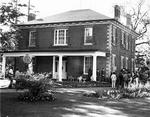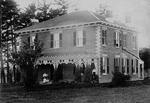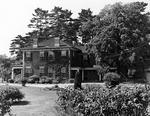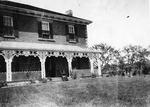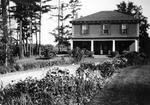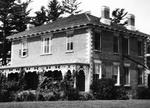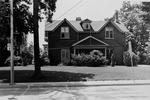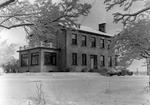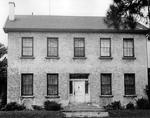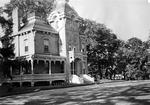Results
- This photograph depicts the Whitby Centennial Building--a community centre that was originally used as a courthouse for Ontario County until 1964. This photograph was taken as part of a promotional fThis photograph depicts the Whitby Centennial Building--a community centre that was originally …
- The Lynde House was built during the War of 1812 and moved to Cullen Gardens on August 22, 1986. In June 1988 it was opened as a museum, and closed at the end of 2005, when Cullen Gardens was sold toThe Lynde House was built during the War of 1812 and moved …
- 'Inverlynn' was built at the intersection of Ragland and Giffard Streets in 1860 for William Laing (1818-1891). In 1870, the house was purchased by George McGillivray (1813-1894) and has remained in'Inverlynn' was built at the intersection of Ragland and Giffard Streets in …
- 'Inverlynn' was built at the intersection of Ragland and Giffard Streets in 1860 for William Laing (1818-1891). In 1870 the house was purchased by George McGillivray (1813-1894) and has been owned by'Inverlynn' was built at the intersection of Ragland and Giffard Streets in …
- Inverlynn, at the northwest corner of Raglan and Giffard Streets, was built in 1860. In 1971 the Canadian Broadcasting Corporation filmed the outdoor scenes for the television series 'Whiteoaks of JaInverlynn, at the northwest corner of Raglan and Giffard Streets, was built …
- Inverlynn was built in 1860 for William Laing. Since 1870 it has been owned by the family of George McGillivray and his descendants.Inverlynn was built in 1860 for William Laing. Since 1870 it has …
- Inverlynn was built in 1860 as the home of William Laing. Mr. Laing lost the house in the grain depression of 1865, and it was purchased in 1870 by George McGillivray. His descendants still live in tInverlynn was built in 1860 as the home of William Laing. Mr. …
- Inverlynn was built in 1860 for William Laing and since 1870 it has been owned by the family of George McGillivray and his descendants. This picture shows the back of the house and the tail wing withInverlynn was built in 1860 for William Laing and since 1870 it …
- Inverlynn was built in 1860 for William Laing and since 1870 it has been owned by the family of George McGillivray and his descendants. This picture shows the front of the house with a woman sittingInverlynn was built in 1860 for William Laing and since 1870 it …
- Inverlynn was built in 1860 for William Laing and since 1870 was owned by the family of George McGillivray and his descendants. This picture shows the front of the house with flowers growing along thInverlynn was built in 1860 for William Laing and since 1870 was …
- Inverlynn was built in 1860 by William Laing and has been owned by the family of George McGillivray and his descendants since 1870. This picture shows the front and east side of the house with the orInverlynn was built in 1860 by William Laing and has been owned …
- This house was built in the 1850s or 1860s and demolished in 1980.This house was built in the 1850s or 1860s and demolished in …
- This brick house was built in 1877 on the block bounded by Dundas, Henry, Colborne, and King Streets. It was demolished in 1958. The owners of the house were G. Y. Smith, a lawyer and later a judge,This brick house was built in 1877 on the block bounded by …
- This house was built for James Rogers Armstrong in 1855 and demolished in 1976. It was the home of Julian Beecroft in 1970.This house was built for James Rogers Armstrong in 1855 and demolished …
- This house was built for James R. Armstrong in 1855 and was the residence of the Beecroft family from 1918 to 1976. This house was demolished in 1976.This house was built for James R. Armstrong in 1855 and was …
- This house was built in 1855 for James Rogers Armstrong. It was purchased in 1918 by Frank Lloyd Beecroft and demolished in 1976. This is a front view of the house.This house was built in 1855 for James Rogers Armstrong. It was …
- This house was built for James Rogers Armstrong in 1855. In 1918 it was purchased by Frank Lloyd Beecroft, and was demolished in 1976. This view shows the west side of the house and the front which fThis house was built for James Rogers Armstrong in 1855. In 1918 …
- This brick house was built in 1877 on the block bounded by Dundas, Henry, Colborne, and King Streets. It was demolished in 1958. The owners of the house were G. Y. Smith a lawyer and later a judge, aThis brick house was built in 1877 on the block bounded by …
- This brick house was built in 1877 on the block bounded by Dundas, Henry, Colborne, and King Streets. It was demolished in 1958. The owners of the house were G. Y. Smith, a lawyer and later a judge,This brick house was built in 1877 on the block bounded by …
- This brick house was built in 1877 on the block bounded by Dundas, Henry, Colborne, and King Streets. It was demolished in 1958. The owners of the house were G. Y. Smith, a lawyer and later a judge,This brick house was built in 1877 on the block bounded by …










